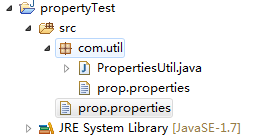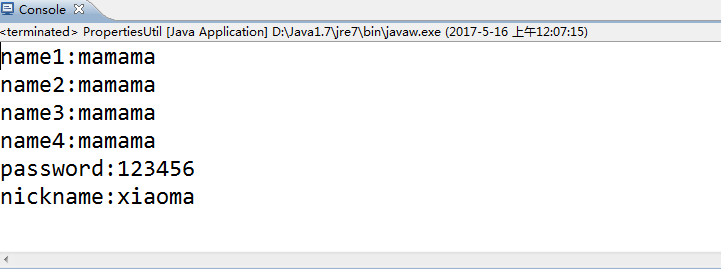java加载properties文件的方式主要分为两大类:一种是通过import java.util.Properties类中的load(InputStream in)方法加载;
另一种是通过import java.util.ResourceBundle类的getBundle(String baseName)方法加载。
注意:一定要区分路径格式
实现代码如下:
|
1
2
3
4
5
6
7
8
9
10
11
12
13
14
15
16
17
18
19
20
21
22
23
24
25
26
27
28
29
30
31
32
33
34
35
36
37
38
39
40
41
42
43
44
45
46
47
48
49
50
51
52
53
54
55
56
57
58
59
60
61
62
63
64
65
66
67
68
69
70
71
72
73
74
75
76
77
78
79
80
81
82
83
84
85
86
87
88
89
90
91
92
93
94
95
96
97
98
99
100
101
102
103
104
105
106
107
108
109
110
111
112
113
114
115
116
117
118
119
120
121
122
123
124
125
126
127
128
129
130
131
|
package com.util;import java.io.FileInputStream;import java.io.FileNotFoundException;import java.io.IOException;import java.io.InputStream;import java.util.Properties;import java.util.PropertyResourceBundle;import java.util.ResourceBundle;public class PropertiesUtil { private static String basePath = "src/prop.properties"; private static String name = ""; private static String nickname = ""; private static String password = ""; /** * 一、 使用java.util.Properties类的load(InputStream in)方法加载properties文件 * */ public static String getName1() { try { Properties prop = new Properties(); InputStream is = new FileInputStream(basePath); prop.load(is); name = prop.getProperty("username"); } catch (FileNotFoundException e) { e.printStackTrace(); } catch (IOException e) { e.printStackTrace(); } return name; } /** * 二、 使用class变量的getResourceAsStream()方法 * 注意:getResourceAsStream()读取路径是与本类的同一包下 * */ public static String getName2() { Properties prop = new Properties(); InputStream is = PropertiesUtil.class .getResourceAsStream("/com/util/prop.properties"); try { prop.load(is); name = prop.getProperty("username"); } catch (IOException e) { e.printStackTrace(); } return name; } /** * 三、 * 使用class.getClassLoader()所得到的java.lang.ClassLoader的getResourceAsStream()方法 * getResourceAsStream(name)方法的参数必须是包路径+文件名+.后缀 否则会报空指针异常 * */ public static String getName3() { Properties prop = new Properties(); InputStream is = PropertiesUtil.class.getClassLoader() .getResourceAsStream("com/util/prop.properties"); try { prop.load(is); } catch (IOException e) { e.printStackTrace(); } return name; } /** * 四、 使用java.lang.ClassLoader类的getSystemResourceAsStream()静态方法 * getSystemResourceAsStream()方法的参数格式也是有固定要求的 * */ public static String getName4() { Properties prop = new Properties(); InputStream is = ClassLoader .getSystemResourceAsStream("com/util/prop.properties"); try { prop.load(is); name = prop.getProperty("username"); } catch (IOException e) { e.printStackTrace(); } return name; } /** * 五、 使用java.util.ResourceBundle类的getBundle()方法 * 注意:这个getBundle()方法的参数只能写成包路径+properties文件名,否则将抛异常 * */ public static String getName5() { ResourceBundle rb = ResourceBundle.getBundle("com/util/prop"); password = rb.getString("password"); return password; } /** * 六、 使用java.util.PropertyResourceBundle类的构造函数 * */ public static String getName6() { try { InputStream is = new FileInputStream(basePath); ResourceBundle rb = new PropertyResourceBundle(is); nickname = rb.getString("nickname"); } catch (FileNotFoundException e) { e.printStackTrace(); } catch (IOException e) { e.printStackTrace(); } return nickname; } /** * 测试 * */ public static void main(String[] args) { System.out.println("name1:" + PropertiesUtil.getName1()); System.out.println("name2:" + PropertiesUtil.getName2()); System.out.println("name3:" + PropertiesUtil.getName3()); System.out.println("name4:" + PropertiesUtil.getName4()); System.out.println("password:" + PropertiesUtil.getName5()); System.out.println("nickname:" + PropertiesUtil.getName6()); }} |
文件路径:

prop.properties文件:
username=mamama
nickname=xiaoma
password=123456
输出结果:

以上就是本文的全部内容,希望对大家的学习有所帮助,也希望大家多多支持服务器之家。
原文链接:https://www.cnblogs.com/heizai002/p/6859121.html















